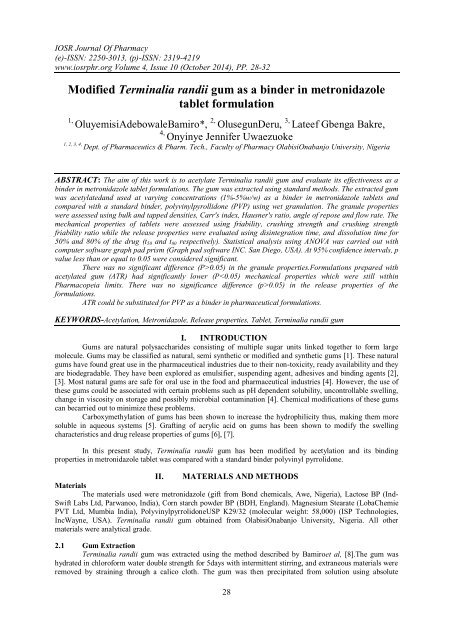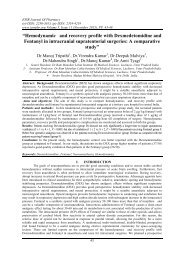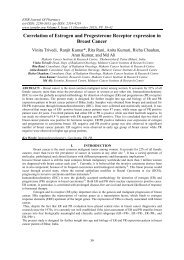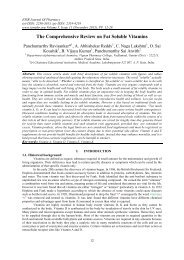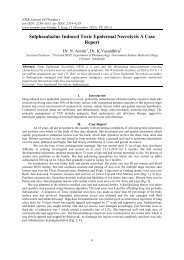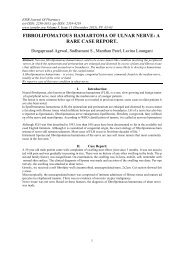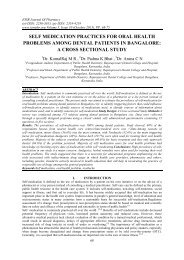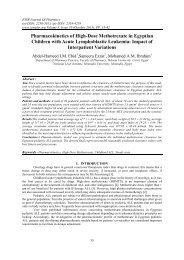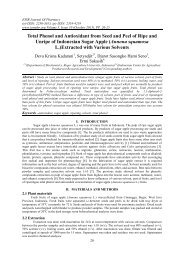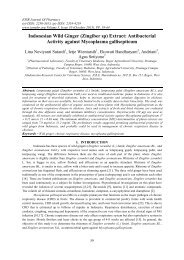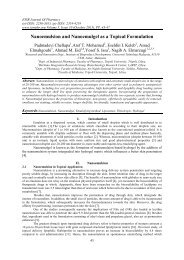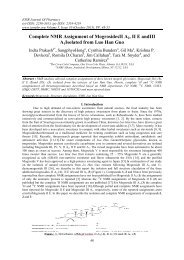Modified Terminalia randii gum as a binder in metronidazole tablet formulation
Create successful ePaper yourself
Turn your PDF publications into a flip-book with our unique Google optimized e-Paper software.
IOSR Journal Of Pharmacy<br />
(e)-ISSN: 2250-3013, (p)-ISSN: 2319-4219<br />
www.iosrphr.org Volume 4, Issue 10 (October 2014), PP. 28-32<br />
<strong>Modified</strong> <strong>Term<strong>in</strong>alia</strong> <strong>randii</strong> <strong>gum</strong> <strong>as</strong> a <strong>b<strong>in</strong>der</strong> <strong>in</strong> <strong>metronidazole</strong><br />
<strong>tablet</strong> <strong>formulation</strong><br />
1,<br />
OluyemisiAdebowaleBamiro*, 2, OlusegunDeru, 3, Lateef Gbenga Bakre,<br />
4,<br />
Ony<strong>in</strong>ye Jennifer Uwaezuoke<br />
1, 2, 3, 4,<br />
Dept. of Pharmaceutics & Pharm. Tech., Faculty of Pharmacy OlabisiOnabanjo University, Nigeria<br />
ABSTRACT: The aim of this work is to acetylate <strong>Term<strong>in</strong>alia</strong> <strong>randii</strong> <strong>gum</strong> and evaluate its effectiveness <strong>as</strong> a<br />
<strong>b<strong>in</strong>der</strong> <strong>in</strong> <strong>metronidazole</strong> <strong>tablet</strong> <strong>formulation</strong>s. The <strong>gum</strong> w<strong>as</strong> extracted us<strong>in</strong>g standard methods. The extracted <strong>gum</strong><br />
w<strong>as</strong> acetylatedand used at vary<strong>in</strong>g concentrations (1%-5%w/w) <strong>as</strong> a <strong>b<strong>in</strong>der</strong> <strong>in</strong> <strong>metronidazole</strong> <strong>tablet</strong>s and<br />
compared with a standard <strong>b<strong>in</strong>der</strong>, polyv<strong>in</strong>ylpyrollidone (PVP) us<strong>in</strong>g wet granulation. The granule properties<br />
were <strong>as</strong>sessed us<strong>in</strong>g bulk and tapped densities, Carr's <strong>in</strong>dex, Hausner's ratio, angle of repose and flow rate. The<br />
mechanical properties of <strong>tablet</strong>s were <strong>as</strong>sessed us<strong>in</strong>g friability, crush<strong>in</strong>g strength and crush<strong>in</strong>g strength<br />
friability ratio while the rele<strong>as</strong>e properties were evaluated us<strong>in</strong>g dis<strong>in</strong>tegration time, and dissolution time for<br />
50% and 80% of the drug (t 50 and t 80 respectively). Statistical analysis us<strong>in</strong>g ANOVA w<strong>as</strong> carried out with<br />
computer software graph pad prism (Graph pad software INC. San Diego, USA). At 95% confidence <strong>in</strong>tervals, p<br />
value less than or equal to 0.05 were considered significant.<br />
There w<strong>as</strong> no significant difference (P>0.05) <strong>in</strong> the granule properties.Formulations prepared with<br />
acetylated <strong>gum</strong> (ATR) had significantly lower (P0.05) <strong>in</strong> the rele<strong>as</strong>e properties of the<br />
<strong>formulation</strong>s.<br />
ATR could be substituted for PVP <strong>as</strong> a <strong>b<strong>in</strong>der</strong> <strong>in</strong> pharmaceutical <strong>formulation</strong>s.<br />
KEYWORDS-Acetylation, Metronidazole, Rele<strong>as</strong>e properties, Tablet, <strong>Term<strong>in</strong>alia</strong> <strong>randii</strong> <strong>gum</strong><br />
I. INTRODUCTION<br />
Gums are natural polysaccharides consist<strong>in</strong>g of multiple sugar units l<strong>in</strong>ked together to form large<br />
molecule. Gums may be cl<strong>as</strong>sified <strong>as</strong> natural, semi synthetic or modified and synthetic <strong>gum</strong>s [1]. These natural<br />
<strong>gum</strong>s have found great use <strong>in</strong> the pharmaceutical <strong>in</strong>dustries due to their non-toxicity, ready availability and they<br />
are biodegradable. They have been explored <strong>as</strong> emulsifier, suspend<strong>in</strong>g agent, adhesives and b<strong>in</strong>d<strong>in</strong>g agents [2],<br />
[3]. Most natural <strong>gum</strong>s are safe for oral use <strong>in</strong> the food and pharmaceutical <strong>in</strong>dustries [4]. However, the use of<br />
these <strong>gum</strong>s could be <strong>as</strong>sociated with certa<strong>in</strong> problems such <strong>as</strong> pH dependent solubility, uncontrollable swell<strong>in</strong>g,<br />
change <strong>in</strong> viscosity on storage and possibly microbial contam<strong>in</strong>ation [4]. Chemical modifications of these <strong>gum</strong>s<br />
can becarried out to m<strong>in</strong>imize these problems.<br />
Carboxymethylation of <strong>gum</strong>s h<strong>as</strong> been shown to <strong>in</strong>cre<strong>as</strong>e the hydrophilicity thus, mak<strong>in</strong>g them more<br />
soluble <strong>in</strong> aqueous systems [5]. Graft<strong>in</strong>g of acrylic acid on <strong>gum</strong>s h<strong>as</strong> been shown to modify the swell<strong>in</strong>g<br />
characteristics and drug rele<strong>as</strong>e properties of <strong>gum</strong>s [6], [7].<br />
In this present study, <strong>Term<strong>in</strong>alia</strong> <strong>randii</strong> <strong>gum</strong> h<strong>as</strong> been modified by acetylation and its b<strong>in</strong>d<strong>in</strong>g<br />
properties <strong>in</strong> <strong>metronidazole</strong> <strong>tablet</strong> w<strong>as</strong> compared with a standard <strong>b<strong>in</strong>der</strong> polyv<strong>in</strong>yl pyrrolidone.<br />
II. MATERIALS AND METHODS<br />
Materials<br />
The materials used were <strong>metronidazole</strong> (gift from Bond chemicals, Awe, Nigeria), Lactose BP (Ind-<br />
Swift Labs Ltd, Parwanoo, India), Corn starch powder BP (BDH, England). Magnesium Stearate (LobaChemie<br />
PVT Ltd, Mumbia India), Polyv<strong>in</strong>ylpyrrolidoneUSP K29/32 (molecular weight: 58,000) (ISP Technologies,<br />
IncWayne, USA). <strong>Term<strong>in</strong>alia</strong> <strong>randii</strong> <strong>gum</strong> obta<strong>in</strong>ed from OlabisiOnabanjo University, Nigeria. All other<br />
materials were analytical grade.<br />
2.1 Gum Extraction<br />
<strong>Term<strong>in</strong>alia</strong> <strong>randii</strong> <strong>gum</strong> w<strong>as</strong> extracted us<strong>in</strong>g the method described by Bamiroet al, [8].The <strong>gum</strong> w<strong>as</strong><br />
hydrated <strong>in</strong> chloroform water double strength for 5days with <strong>in</strong>termittent stirr<strong>in</strong>g, and extraneous materials were<br />
removed by stra<strong>in</strong><strong>in</strong>g through a calico cloth. The <strong>gum</strong> w<strong>as</strong> then precipitated from solution us<strong>in</strong>g absolute<br />
28
<strong>Modified</strong> term<strong>in</strong>alia <strong>randii</strong> <strong>gum</strong> <strong>as</strong> a <strong>b<strong>in</strong>der</strong> <strong>in</strong> <strong>metronidazole</strong> <strong>tablet</strong> <strong>formulation</strong><br />
ethanol. The precipitated <strong>gum</strong> w<strong>as</strong> filtered w<strong>as</strong>hed with diethyl ether and then dried <strong>in</strong> a hot air oven at 40 o C for<br />
24 hours. The purified <strong>gum</strong> w<strong>as</strong> then pulverized and packed <strong>in</strong> an airtight conta<strong>in</strong>er.<br />
2.2 Acetylation of <strong>Term<strong>in</strong>alia</strong> <strong>randii</strong> <strong>gum</strong><br />
Extracted <strong>gum</strong> (10g) w<strong>as</strong> dispersed <strong>in</strong> 100ml of distilled water with constant stirr<strong>in</strong>gfor 30m<strong>in</strong>s.The<br />
slurry w<strong>as</strong> adjusted to pH 8.0 with NaOH. 1.2g of acetic anhydride w<strong>as</strong> added to the slurry and the reaction w<strong>as</strong><br />
allowed to proceed for another 5 m<strong>in</strong>utes. The pH of the slurry w<strong>as</strong> adjusted to 4.5 with 0.5M HCL and then<br />
filtered through Wathman filter 1 paper. The residue w<strong>as</strong> thoroughly w<strong>as</strong>hed with distilled water to completely<br />
remove some acid that may be present <strong>in</strong> the product and f<strong>in</strong>ally air dried at room temperature. The acetylated<br />
<strong>gum</strong> w<strong>as</strong> characterised us<strong>in</strong>g Fourier Transform Infrared Spectroscopy (FTIR).<br />
2.3 FTIR of acetylated and natural <strong>Term<strong>in</strong>alia</strong> <strong>gum</strong><br />
The FTIR spectrum of the <strong>gum</strong> w<strong>as</strong> recorded with a Perk<strong>in</strong> Elmer RXI spectrophotometer<br />
(Connecticut, USA). The dry <strong>gum</strong> powder w<strong>as</strong> mixed with pot<strong>as</strong>sium bromide (KBr) and pressed <strong>in</strong>to pellets.<br />
The spectrum w<strong>as</strong> obta<strong>in</strong>ed by scann<strong>in</strong>g between 4000 and 500cm -1<br />
2.4 Tablet Preparation<br />
100g batch sizes were prepared conta<strong>in</strong><strong>in</strong>g 60 % w/w <strong>metronidazole</strong> (drug), 30 % w/w lactose (diluent)<br />
and 10% w/w corn starch (dis<strong>in</strong>tegrant). Metronidazole granules were prepared us<strong>in</strong>g wet granulation method.<br />
Acetylated <strong>Term<strong>in</strong>alia</strong> <strong>gum</strong> (ATR) w<strong>as</strong> used <strong>as</strong> a <strong>b<strong>in</strong>der</strong> at different concentrations (1-5 % w/w), while PVP w<strong>as</strong><br />
used <strong>as</strong> a standard. The granule properties of the granules were evaluated us<strong>in</strong>g USP 2007 methods. The<br />
granules were compressed on a Carvierhydraulic mach<strong>in</strong>e (Model C, Carver Inc., Menomonee Falls, WI) with<br />
predeterm<strong>in</strong>ed load for 30 seconds. The <strong>tablet</strong>s were stored <strong>in</strong> air tight conta<strong>in</strong>ers for 24 hours to allow for<br />
el<strong>as</strong>tic recovery.<br />
2.5 Tablet properties<br />
Friability w<strong>as</strong> determ<strong>in</strong>ed with a DBK friabilator test apparatus (Mumbai, India) set to rotate at 25 rpm<br />
for 4 m<strong>in</strong>utes. Determ<strong>in</strong>ations were done <strong>in</strong> triplicate.<br />
Crush<strong>in</strong>g strength w<strong>as</strong> determ<strong>in</strong>ed with a DBK Instrument Tablet Hardness Tester MODEL EH 01.<br />
Five <strong>tablet</strong>s were taken from each batch and the results were given <strong>as</strong> mean ±SD.<br />
Dis<strong>in</strong>tegration test w<strong>as</strong> carried out <strong>in</strong> distilled water at a temperature of 37±0.5 0 C <strong>in</strong> a DBK Tablet<br />
Dis<strong>in</strong>tegration test apparatus (Mumbai, India). Determ<strong>in</strong>ations were done <strong>in</strong> quadruplicates.<br />
The <strong>in</strong> vitro dissolution test w<strong>as</strong> carried out <strong>in</strong> 900ml 0f 0.1M HCL at a constant temperature of 37<br />
±0.05 0 C us<strong>in</strong>g a rotat<strong>in</strong>g b<strong>as</strong>ket apparatus method rotated at 100 rpm. 5 mL samples were withdrawn at different<br />
time <strong>in</strong>tervals and replaced with fresh samples. The amount of <strong>metronidazole</strong> rele<strong>as</strong>ed <strong>in</strong> each sample w<strong>as</strong><br />
determ<strong>in</strong>ed us<strong>in</strong>g a UV spectrophotometer (Cecil CT 2041200 series) at a wavelength of 277nm. Determ<strong>in</strong>ations<br />
were done <strong>in</strong> triplicates.<br />
Statistical analysis w<strong>as</strong> carried out us<strong>in</strong>g ANOVA (analysis of variance) with computer software graph pad<br />
prism 4 (Graph pad software Inc. San Diego, USA). At 95% confidence <strong>in</strong>terval, p ≤ 0.05 were considered<br />
significant.<br />
III. RESULTS AND DISCUSSION<br />
The FTIR of<strong>Term<strong>in</strong>alia</strong> <strong>randii</strong> <strong>gum</strong> and acetylated <strong>Term<strong>in</strong>alia</strong> <strong>randii</strong> <strong>gum</strong> are presented <strong>in</strong> Figs. 1 and<br />
2. The peak at 1749cm -1 is a C=O stretch<strong>in</strong>g which <strong>in</strong>dicates esterification which is brought about by the<br />
presence of an acetyl group.<br />
The granule properties are presented <strong>in</strong> Table 1. The mean granule size w<strong>as</strong> observed to <strong>in</strong>cre<strong>as</strong>e with<br />
<strong>in</strong>cre<strong>as</strong>e <strong>in</strong> <strong>b<strong>in</strong>der</strong> concentration. This could be attributed to strengthen<strong>in</strong>g of bonds between particles <strong>as</strong> there<br />
would be more <strong>b<strong>in</strong>der</strong> per bond <strong>as</strong> the concentration is <strong>in</strong>cre<strong>as</strong>ed [9], [10]. The bulk densities generally<br />
decre<strong>as</strong>ed with <strong>in</strong>cre<strong>as</strong>e <strong>in</strong> <strong>b<strong>in</strong>der</strong> concentration. The flowability of a material is an important parameter <strong>in</strong> the<br />
production of <strong>tablet</strong>s. The flow properties were determ<strong>in</strong>ed by evaluat<strong>in</strong>g the angle of repose, Hausner’s ratio,<br />
Carr’s <strong>in</strong>dex and the flow rate. Angle of repose less than 25 o <strong>in</strong>dicates very good flow, 25 o to less than 50 o<br />
<strong>in</strong>dicates good flow while greater than 50 o is poor flow. Granules produced by the two <strong>b<strong>in</strong>der</strong>s exhibited good<br />
flow property. The Carr’s <strong>in</strong>dex is a me<strong>as</strong>ure of the flow-ability and compressibility of a material. All the<br />
granule <strong>formulation</strong>s had Carr’s <strong>in</strong>dex of less than 15 o which <strong>in</strong>dicates good flow properties. Hausner’s ratio less<br />
than 1.2 <strong>in</strong>dicates good flow. All the <strong>formulation</strong>s had less than 1.2, <strong>in</strong>dicat<strong>in</strong>g good flow [11].<br />
29
<strong>Modified</strong> term<strong>in</strong>alia <strong>randii</strong> <strong>gum</strong> <strong>as</strong> a <strong>b<strong>in</strong>der</strong> <strong>in</strong> <strong>metronidazole</strong> <strong>tablet</strong> <strong>formulation</strong><br />
The <strong>tablet</strong> properties are presented <strong>in</strong> Table 2. The mechanical properties of a pharmaceutical <strong>tablet</strong> are<br />
quantified by crush<strong>in</strong>g strength and friability. These are ability of the <strong>tablet</strong>s to withstand the rigors of<br />
transportation, dispens<strong>in</strong>g and handl<strong>in</strong>g [12]. The friability w<strong>as</strong> observed to decre<strong>as</strong>e <strong>as</strong> concentration of <strong>b<strong>in</strong>der</strong><br />
<strong>in</strong>cre<strong>as</strong>ed, while crush<strong>in</strong>g strength <strong>in</strong>cre<strong>as</strong>ed with <strong>in</strong>cre<strong>as</strong>e <strong>in</strong> concentration of <strong>b<strong>in</strong>der</strong>. This could be due to the<br />
heat produced dur<strong>in</strong>g the compression of the <strong>tablet</strong>s which caused melt<strong>in</strong>g of b<strong>in</strong>d<strong>in</strong>g agent, which on cool<strong>in</strong>g<br />
solidify to form strong solid bonds between the particles. All the <strong>formulation</strong>s p<strong>as</strong>sed the friability test by<br />
show<strong>in</strong>g friability values of less than 1% w/w [13]. The mechanical properties of <strong>formulation</strong>s conta<strong>in</strong><strong>in</strong>g ATR<br />
were significantly lower (p
B<strong>in</strong>der<br />
Conc<br />
of<br />
b<strong>in</strong>de<br />
r<br />
Bulk density<br />
(g/ml)<br />
<strong>Modified</strong> term<strong>in</strong>alia <strong>randii</strong> <strong>gum</strong> <strong>as</strong> a <strong>b<strong>in</strong>der</strong> <strong>in</strong> <strong>metronidazole</strong> <strong>tablet</strong> <strong>formulation</strong><br />
Table 1: Micromeritic Properties of Granules<br />
Tapped<br />
density<br />
(g/ml)<br />
Flow rate<br />
(g/sec)<br />
Angle<br />
repose<br />
( O )<br />
of<br />
Carr’s<br />
<strong>in</strong>dex<br />
( O / O )<br />
Hausner<br />
ratio<br />
Contro 0.00 0.483±0.00 0.523±0.01 3.95±0.44 35.24±0.21 7.62±1.77 1.07±0.01 445<br />
Mean<br />
granule size<br />
µm<br />
PVP 1.00 0.416±0.20 0.450±0.00 4.74±0.52 36.74±0.56 7.41±1.28 1.08±0.01 485<br />
2.00 0.396±0.18 0.430±0.00 5.90±0.56 37.35±0.21 7.53±1.33 1.08±0.01 515<br />
3.00 0.416±0.19 0.430±0.00 6.63±0.57 36.62±0.21 3.10±1.33 1.03±0.01 585<br />
5.00 0.410±0.18 0.453±0.00 7.88±0.60 36.00±0.21 9.54±1.13 1.10±0.01 710<br />
ATR 1.00 0.427±0.00 0.433±0.00 5.20±0.41 48.86±0.56 1.55±1.34 1.01±0.01 755<br />
2.00 0.410±0.00 0.430±0.00 5.73±0.31 48.57±0.52 4.65±0.00 1.05±0.00 765<br />
3.00 0.400±0.01 0.440±0.01 7.22±0.29 49.63±0.14 9.09±0.20 1.09±0.00 770<br />
5.00 0.407±0.00 0.417±0.01 9.78±0.47 49.22±0.42 2.32±4.02 1.02±0.04 860<br />
The rele<strong>as</strong>e properties of the <strong>tablet</strong>s were <strong>as</strong>sessed us<strong>in</strong>g dis<strong>in</strong>tegration and dissolution times (t 50 and t 80<br />
i.e. time required for 50% and 80% of the drug to be rele<strong>as</strong>ed respectively). The dis<strong>in</strong>tegration time of <strong>tablet</strong>s is<br />
the rate limit<strong>in</strong>g step <strong>in</strong> dissolution and consequently absorption of the active <strong>in</strong>gredient. The British<br />
Pharmacopoeia [13], states that uncoated <strong>tablet</strong>s must dis<strong>in</strong>tegrate with<strong>in</strong> 15 m<strong>in</strong>utes. All the <strong>formulation</strong>s<br />
dis<strong>in</strong>tegrated <strong>in</strong> less than 15 m<strong>in</strong>utes. The result of the rele<strong>as</strong>e properties are presented <strong>in</strong> Table 2. The<br />
dis<strong>in</strong>tegration time w<strong>as</strong> observed to <strong>in</strong>cre<strong>as</strong>e with <strong>in</strong>cre<strong>as</strong>e <strong>in</strong> concentration of <strong>b<strong>in</strong>der</strong>.Formulations conta<strong>in</strong><strong>in</strong>g<br />
ATR at 5 % w/w had significantly lower (p0.05) <strong>in</strong> the dissolution time.<br />
Table 2: Tablet Properties<br />
B<strong>in</strong>der<br />
PVP<br />
ATR<br />
Concentration<br />
(% w/w)<br />
Friability<br />
(%)<br />
Crush<strong>in</strong>g<br />
strength<br />
(N)<br />
CSFR<br />
Dis<strong>in</strong>tegration<br />
time<br />
(M<strong>in</strong>)<br />
T 50<br />
(m<strong>in</strong>)<br />
T 80<br />
(m<strong>in</strong>)<br />
0.00 0.36±0.01 18.58±2.97 51.61 0.03±0.00 2.35 4.45<br />
1.00 0.53±0.03 27.46±3.80 51.81 0.07±0.01 2.35 4.50<br />
2.00 0.48±0.01 59.54±3.45 124.04 0.14±0.01 2.52 4.75<br />
3.00 0.44±0.01 96.68±3.88 219.72 0.38±0.06 2.75 5.25<br />
5.00 0.45±0.04 104.88±3.57 233.07 0.79±0.02 2.80 5.75<br />
1.00 0.69±0.02 22.56±2.86 32.70 0.07±0.02 2.25 5.25<br />
2.00 0.40±0.01 26.58±2.78 66.45 0.22±0.01 1.85 3.75<br />
3.00 0.30±0.02 39.56±3.00 131.87 0.31±0.00 2.35 5.35<br />
5.00 0.36±0.02 31.72±3.45 88.11 0.38±0.05 2.55 5.75<br />
31
<strong>Modified</strong> term<strong>in</strong>alia <strong>randii</strong> <strong>gum</strong> <strong>as</strong> a <strong>b<strong>in</strong>der</strong> <strong>in</strong> <strong>metronidazole</strong> <strong>tablet</strong> <strong>formulation</strong><br />
Figure 3: Plots of percentage <strong>metronidazole</strong> rele<strong>as</strong>ed aga<strong>in</strong>st time <strong>in</strong> <strong>formulation</strong>s conta<strong>in</strong><strong>in</strong>g 5% w/w ATR and<br />
PVP<br />
IV. CONCLUSION<br />
The data obta<strong>in</strong>ed from this study <strong>in</strong>dicates that acetylated <strong>Term<strong>in</strong>alia</strong> <strong>randii</strong> <strong>gum</strong> could be substituted<br />
for polyv<strong>in</strong>yl pyrrolidone<strong>as</strong> a <strong>b<strong>in</strong>der</strong> <strong>in</strong> <strong>tablet</strong> <strong>formulation</strong>s, especially where a <strong>tablet</strong> that is not “too strong” but<br />
with similar rele<strong>as</strong>e property is required.<br />
REFERENCES<br />
[1] K. OforiKwakye, Y. Asantewaa and S. Lugrie kipo.Physicochemical and B<strong>in</strong>d<strong>in</strong>g Properties of c<strong>as</strong>hew tree <strong>gum</strong> <strong>in</strong> metronidazo<br />
le<strong>tablet</strong> <strong>formulation</strong>s.Int.J Pharm Pharm Sci, 2( 4), 2010, 105109<br />
[2] H. Rahim, M. A Khan, A. Badshah, K.A Chishti, S. Khan and M. Junaid. Evaluation of Prunusdomestica <strong>gum</strong> <strong>as</strong> a novel <strong>tablet</strong><br />
<strong>b<strong>in</strong>der</strong>. BJPS, 50(1), 2014, 195-202.<br />
[3] R. Kumar, S.R. Patil, M. B. Patil, M. S. P<strong>as</strong>chapur, R. Mahalaxmi Isolation and evaluation of the emulsify<strong>in</strong>g properties of<br />
tamar<strong>in</strong>d seed polysaccharide on c<strong>as</strong>tor oil emulsion. Der Pharmacia Lettre, 2 (1), 2010, 518-527<br />
[4] V. Rana, P. Rai, A.K. Tiwary, R.S. S<strong>in</strong>gh, J.F. Kennedy and C.J.Knill. <strong>Modified</strong> <strong>gum</strong>s: Approaches and applications <strong>in</strong> drug<br />
delivery. Carbohydrate Polymers, 83, 2011, 1031-1047.<br />
[5] G. Dodi, D. Hritcu and M. I. Popa. Carboxymethylation of guar <strong>gum</strong>: Synthesis and characterization. Cellulose Chem. Technol.,<br />
45 (3-4), 2011, 171-176<br />
[6] B.R. Sharma, V. Kumar and P.L. Soni. Ceric ammonium nitrate-<strong>in</strong>itiated graft copolymerization of acrylamide onto C<strong>as</strong>sia tora<br />
<strong>gum</strong>. J Appl. Polymer Sci. 90, 2002.3250-3255.<br />
[7] P. Goyal, V.Kumar and P. Sharma. Graft copolymerisation of acrylamide onto tamar<strong>in</strong>d kernel powder <strong>in</strong> the presence of ceric<br />
ion. J Appl. Polymer Sci.108, 2008a, 3696-3701.<br />
[8] O.A Bamiro, V.R S<strong>in</strong>ha, R. Kumar, O.A Odeku. Characterization and evaluation of <strong>Term<strong>in</strong>alia</strong> <strong>randii</strong> <strong>gum</strong> <strong>as</strong> a <strong>b<strong>in</strong>der</strong> <strong>in</strong><br />
carvedilol <strong>tablet</strong> <strong>formulation</strong>. Acta Pharm Sci. 52, 2010, 254-262.<br />
[9] S. Esezobo and V. Ambujan. An evaluation of starch obta<strong>in</strong>ed from Planta<strong>in</strong>-Musa Paradisiaca-As a <strong>b<strong>in</strong>der</strong> and dis<strong>in</strong>tegrant for<br />
compressed <strong>tablet</strong>s. J Pharm Pharmacol, 34,1982, 761-765.<br />
[10] M. Luangtanan-Anan and J.T. Fell. Bond<strong>in</strong>g mechanisms <strong>in</strong> <strong>tablet</strong><strong>in</strong>g. Int J Pharm. 60, 1990, 197-202<br />
[11] J.I Wells, Tablet test<strong>in</strong>g, <strong>in</strong> J. Swarbick, J.C Boylan (14 Ed), Encyclopedia of Pharmaceutical Technology(Marcel Dekker, New<br />
York 1997) 401-418.<br />
[12] G.S Banker and N.R Anderson, Tablets, <strong>in</strong> L. Lachman, H.A Liberman special Indian (Ed), The Theory and practice of<br />
Industrial Pharmacy (CBS Publishers and Distributor, New Dehli, 2009) 293-345<br />
[13] British Pharmacopoaeia (BP). The Commission Office London. 2009; 111: 6578 – 6585<br />
[14] O.A.Odeku and O.AItiola. Evaluation of the effects of Khaya <strong>gum</strong> on the mechanical and rele<strong>as</strong>e properties of paracetamol <strong>tablet</strong><br />
<strong>formulation</strong>. Drug Dev Ind Pharm 29,2003, 311-320.<br />
32


